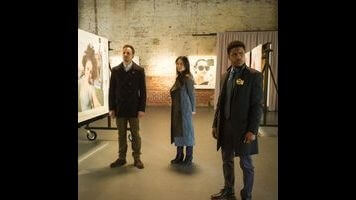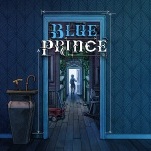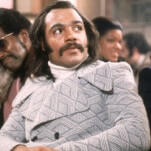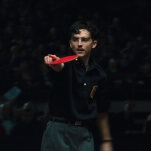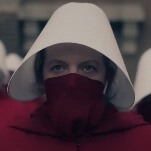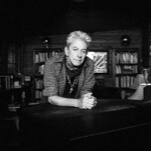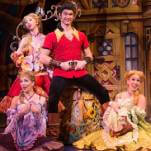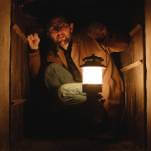There has been a lot of discussion around television recently about the tensions between freedom to tell the stories you want to tell, and negotiating the burden of real-world representation. Some shows navigate it fairly well, usually by telling a story that’s satisfying enough that it earns whatever it chooses to do. Some shows stumble into story disasters that, however accidentally, reflect wider stories in the real world, and that burden of representation overshadows anything the story might have been trying to do. (Or, in the case of Sleepy Hollow, what the story just didn’t even care that it was doing any more.)
To its credit, “Art Imitates Art” very deliberately tries to engage real-world narratives. Two women murder victims, both objectified in different ways by the male gaze. The district attorney; the head of the crime lab; the angry state trooper; the performance artist—all women, all compromised to some degree amid different systems of advantage and power.
And perhaps the procedural is the great equalizer. Perhaps, as it is with Law & Order, you will eventually hit every possible iteration of murderer and victim; perhaps eventually you’ll undermine common tropes in an attempt to provoke some food for thought; perhaps eventually you’ll want to consider an issue and just cross your fingers that nobody notices the logistics of your murderer having to know how to forge art. Perhaps, into every procedural, a “Build Me Up, Buttercup” murder montage must fall.
It’s easy to see the beats in which “Art Imitates Art” is trying to do those things. Young stalker Lewis talks through his own redemption arc, acknowledging his creepy behavior (as “awkward”), getting properly treated for his anxiety disorder; “I take medication now, I don’t get those feelings.” Sherlock and Marcus openly dislike Ephraim’s opportunistic art that “recontextualizes” women’s pictures of themselves into an image he controls. DNA evidence has become a necessary element of the judicial process—and is as subject to assumptions and corruptions as any other aspect of the broken system. At the edges of the frame, this episode might even be suggesting judicial corruption is murder, in terms of sheer harm. (Sherlock’s anger at the corrupt crime-lab supervisor is a small but central moment in “Art Imitates Art.” The system is broken, in ways that Elementary occasionally acknowledges; in order for justice to function, those who can do their best are expected to do it. Sherlock’s bald disgust is telling.)
And yet, the way this case falls out means that that young stalker is not just innocent—he’s a victim. (One of the more surreal sentences ever uttered on the show might be Sherlock’s very casual, “Perhaps, for reasons unknown, he spat on her earlier in the day.”) Sherlock even tries to take his word over the word of a woman who swears they never dated. It’s a case in which a lesbian couple is introduced, given no characterization, and then revealed as murderers. One of them even murdered another lesbian, which must be some kind of TV hat trick!
It’s messy. The male gaze is omnipresent; it’s so universal it’s the default position of the camera, which means that a lesbian character challenges the camera merely by existing. No surprise that many shows hit a snag on a narrative that precarious. But this go-round hits so many lesbian tropes that eventually you just start laughing. Technically Marissa wasn’t killed because of her sexuality, I suppose—a very rare scenario in which one can assume that—but in having her murdered by another lesbian, we head right into Evil Lesbian territory (a lesbian of color, no less). And her district-attorney wife is an even more evil lesbian, who didn’t even kill in the heat of the moment, but instead participated in systemic abuse of the judicial system…and also killed a woman in a drive-by. (And then forged a giant portrait, which at the very least is impressive dedication, I suppose.)
As an audience, we recognize that the pedestal is no more satisfying than the gutter in terms of narrative position. Neither shrewish cutouts nor flawless saints are interesting characters; neither gives us the sense of a real person. In every murder-heavy procedural, a numbers game dictates that, every so often, you’ll hit on a murderer who’s a lesbian. But introducing a lesbian character barely in time to make her a murderer is just…flat. More emphasis is put on the importance of accurate DNA analysis and the circumstance of a selfie appearing in an art gallery than on the character who faces the dangers of buying into a corrupt system, or the one who has wholeheartedly embraced a corrupt system and done terrible things for love. They’re cutouts. It’s awkward.
There are not yet enough queer people in the Elementary universe that these questions can fade into the background. It’s still working under the burden of representation and the burden of the procedural hour, and “Art Imitates Art” hopes that we trust the series enough to give questionable moments the benefit of the doubt. We know it’s not a pedestal; the rest is in the eye of the beholder.
Stray observations
- I won’t get into the “recontextualizing” of this episode as a two-parter when the case had nothing to do with Lin whatsoever and the show was just offering some kind of justification for having her around for more than one episode, but it’s not lost on me.
- Lucy Liu did some more great work in this episode. Her quiet scene with Sherlock, talking over what it means that Lin grew up with their biological father when Joan didn’t; her scene with Lin that’s about coming to terms. Even her gobsmacked hurt as Lin viciously lies to her feels like a side of Joan we rarely get to see, and I appreciate these glimpses.
- Sherlock noting Joan’s been crying was really nicely underplayed; for once, he knows better than to push too far, and as much as I dislike how often Joan deflects her own feelings (largely because the show tends not to revisit those beats), it made sense here.
- Did Sherlock channel his frustration about corrupt law enforcement by stumping the lab team with Clyde’s DNA, or was this simply that part of Sherlock that believes every crime lab should be up to date on the latest turtle DNA techniques in the same way he’s so happy every time Marcus whips out tech talk?
- Sherlock, lover of modern art, on being told that obviously there was a robbery, since there’s no art in the empty spaces: “One might argue there’s no art in the occupied spaces either.”
- Line delivery of the episode comes from Marcus, realizing Ephraim is charging a hundred grand for a repurposed selfie: “I’m surprised we’re not investigating his murder.”
- “That’s nice…I got there twenty minutes ago.”
- Lucy Liu’s face when the performance artist promises, “I would never kill anyone…I’m a vegan,” is honestly priceless.
- The budget for this show is finite, and there was not enough money to pay Detective Gould to talk, and I laughed.
- I really loved that quiet, shared joke between Joan and Lin: “I called your mother today. We talked for a while.” “Your Mandarin must be good.” I think the show made a very unsubtle but potentially rewarding introduction for Lin here; her outburst in the precinct (and even her apology later) suggest someone who has not reached Joan’s level of reflection about life in general or her new family specifically, and I appreciated the tension between them. Even more, I appreciate that it’s slightly open-ended; I hope their relationship deepens, in the slow fullness of time.
